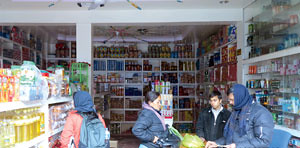
PUJA TANDON
SMALL STEPS: A mini-store in Dadeldhura sells food, cosmetics, and toiletries all under one roof.
Neglected by the state, the far-western region of Nepal and its people have languished in a corner for centuries. A visit to any one of the nine districts often leaves many wondering how a place endowed with great biodiversity and abundant natural resources fell so far behind in its economy?
The decade long civil war undeniably pushed the region’s development back decades. Thousands were displaced, bridges were burnt, cutting access to the markets, food supply networks were destroyed, and most development projects and businesses pulled out.
Investment came to a grinding halt and jobs vanished and the ones who stayed behind had to survive on aid and food rations. Remnants of this aid dependence can still be seen in the bajars where Mercy Corps boards still outnumber advertisement hoardings.
Transboundary relations with India, regulated mostly by the infamous Mahakali Treaty, too has played a critical role in restricting progress in the districts.
The business community is weak (non-existent in certain places) compared to other parts of Nepal. the private sector is slack, the meaning of entrepreneurship is obscure with no one willing to take risks. Businesses talk big but are not ready to stand up to the challenges.
However, there are signs the far-west is slowly waking up from its slumber. The few entrepreneurs who took the plunge are doing well. Banking systems are well-developed and most major banks have branches from Darchula in the north to Kailali in the south.
Although national newspapers reach here the next day, the local Nepali dailies are showing hints of progress and their positive and inclusive coverage is exemplary. Lack of proper health care still plagues the people here, but service delivery by staff mostly trained in India is much better than in the western and central regions.
Tourism and far-western Nepal don’t usually belong in the same sentence, but there is definite potential here to promote the ‘Sundar Sudur Paschimanchal’ brand. Throngs of Indian tourists from neighbouring towns flock to the three casinos in the region, go back before sunset, only to return the next day, leading to a gambling industry boom.
Thousands more cross the border at Kanchanpur/Kailali on their way to Bardia. With good road networks, no water or electricity shortages, and plenty of natural beauty on offer the districts can easily attract transit passengers to stay over for a day or two. Exclusive products like rice wine, banana wine, allo (a local fibre), and Tharu and Rana handicraft just need better branding to capture a wider international market.
If tourism takes off in the region it will help inject much needed cash into the local economy and lift living standards. However, if it happens in an unregulated and unplanned manner, then tourism could end up destroying remaining forests, polluting waterways and lead to exploitation and overcrowding similar to central Nepal. This balance is imperative.
Who should lead the ‘sundar sudur paschimanchal’ campaign? I believe the private sector along with the locals themselves should be at the forefront. But unless people are weaned off aid they won’t be motivated to take risks or start a business. The locals will also need some basic entrepreneurship training which is where grassroots NGOs can step in. And the state for its part should negotiate with India for better border management to facilitate trade and economic activities in the region.